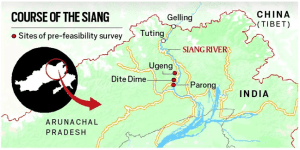TAG: GS 3: ECOLOGY AND ENVIRONMENT
THE CONTEXT: The proposed Upper Siang Multipurpose Storage Project in Arunachal Pradesh has sparked significant controversy and opposition from local communities and activists.
EXPLANATION:
- The project, which aims to generate substantial hydropower, has been met with protests due to its potential environmental and social impacts.
The Upper Siang Project
- The Upper Siang project is an ambitious hydropower initiative set to be built on the Siang River in the Upper Siang district of Arunachal Pradesh.
- The government initially planned two hydel projects with a combined capacity of 9,250 MW.
- However, in 2017, it was proposed to consolidate these into a single, larger project with an installed capacity of 11,000 MW.
- To be executed by the National Hydroelectric Power Corporation (NHPC), this project would involve constructing a 300-meter high dam, the largest in the subcontinent.
- The project is seen for its hydropower potential and as a strategic countermeasure to China’s plans for a massive 60,000 MW ‘super dam’ in Tibet’s Medog county, near the Arunachal Pradesh border.
- This super dam is intended to divert water to China’s northern regions, which could affect the flow of the Siang River into India.
- The Upper Siang project is thus viewed as a crucial reservoir to mitigate any potential reduction in river flow due to upstream Chinese activities.
- Local opposition to the project is grounded in concerns over its environmental and social repercussions.
- Several activist groups, including the Siang Indigenous Farmers Forum (SIFF), Dibang Resistance, and North East Human Rights, have raised alarms about the impact on the region’s ecosystems, wildlife habitats, and biodiversity.
Environmental Impact
- The Siang river, known as Tsangpo in Tibet, is crucial for the region’s delicate ecosystems.
- The construction of such a large dam poses risks to these ecosystems, potentially disrupting the natural habitat and affecting wildlife.
- The memorandum prepared by the anti-dam organizations stresses that the region has already endured numerous hydropower projects, and the additional burden could be detrimental to the local environment.
Social Impact
- One of the most pressing concerns is the displacement of local communities, particularly the Adi tribe, who inhabit more than 300 villages that the project would submerge.
- The district headquarters, Yingkiong, is also at risk.
- The indigenous communities rely heavily on the river for their livelihoods, cultural practices, and sustenance.
- The memorandum highlights that the project threatens their way of life. Given the region’s challenging terrain, there are no viable alternative locations for resettlement.
Preventive Detention of Activists
- Two anti-dam activists were placed in preventive detention on July 8, 2024, in anticipation of the Union Power Minister’s visit.
- The police cited potential public order issues, though the activists intended only to present a memorandum to the minister.
- This incident reflects the tensions between local authorities and the protesting communities.
Public Outreach and CSR Initiatives
- Authorities have initiated extensive public outreach campaigns to garner support for the project.
- The NHPC has allocated a Rs 325 crore CSR package to fund livelihood schemes and develop health, education, and sports infrastructure.
- However, activists remain skeptical of these efforts, viewing them as insufficient to address the fundamental issues of displacement and environmental degradation.
Legal and Strategic Considerations
- The Forest (Conservation) Amendment Act of the previous year is a key legal aspect influencing the project’s progression.
- This amendment exempts strategic projects within 100 km of India’s borders from needing forest clearance.
- Activists argue that framing the Upper Siang project as a matter of national security overlooks the region’s history of resistance to such projects.
Siang River
- The Siang originates near Mount Kailash in Tibet, where it goes by the name of Tsangpo.
- It traverses more than 1,000 km eastward before forming a horseshoe bend around the towering Namcha Barwa peak and entering Arunachal Pradesh as the Siang.
- Further downstream, in Assam, the river becomes the mighty Brahmaputra.
 The course of the Siang
The course of the Siang

